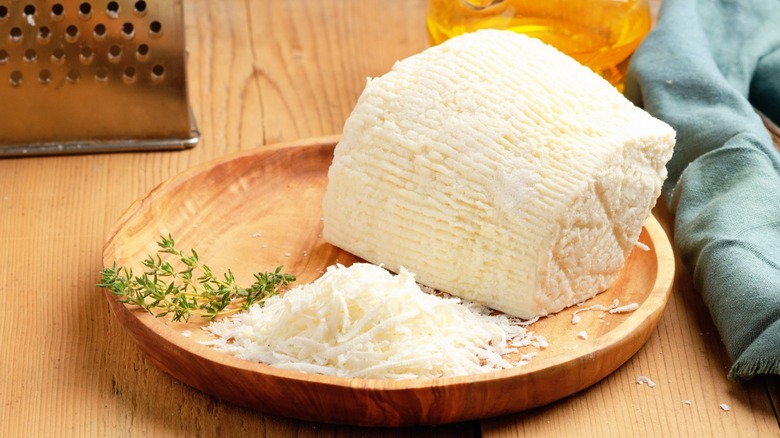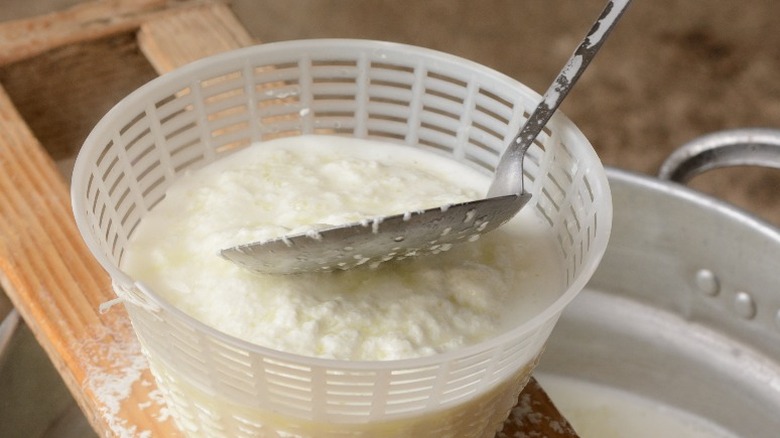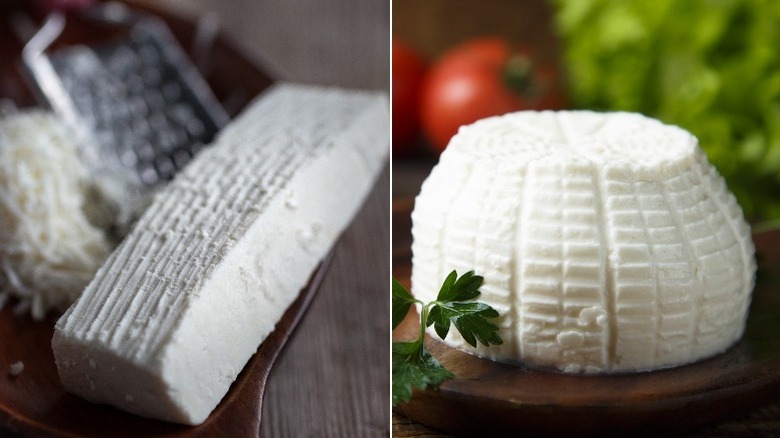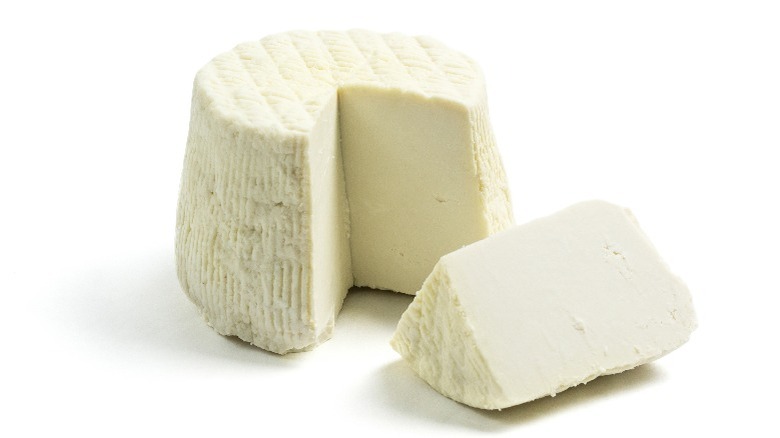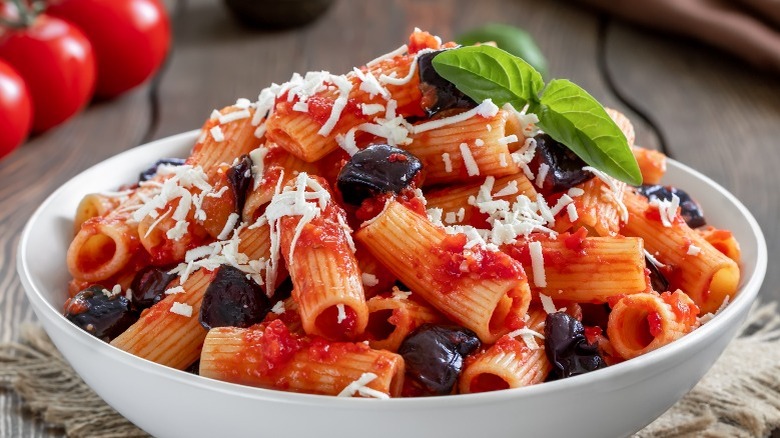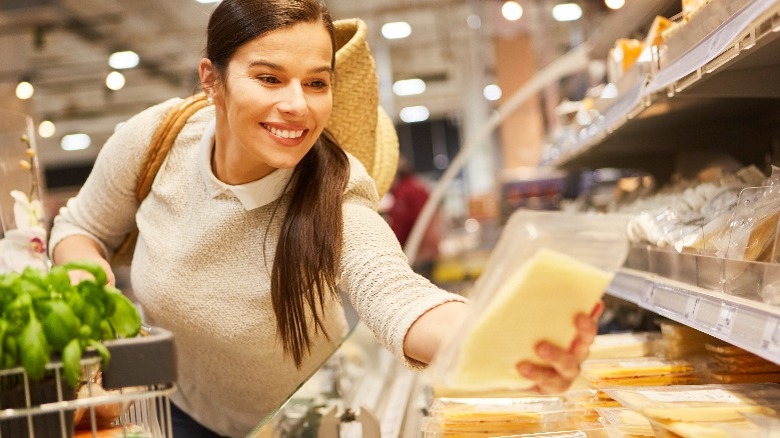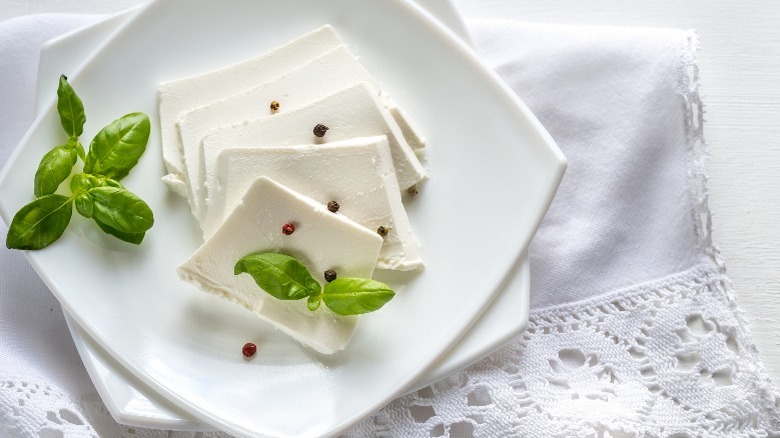What Is Ricotta Salata And How Do You Cook With It?
In the world of Italian cheeses, ricotta may be one of the most popular ones. It can be found in the dairy section of nearly any supermarket across the country, and it shines in such pasta dishes as lasagna. But fewer people are as familiar with its cousin, ricotta salata. Giada De Laurentiis thinks it's underappreciated. And though it's less widely known, ricotta salata holds its own special place in Italian cuisine. Its sharp and salty flavor and firm texture make it a perfect addition to everything from pasta to salad.
The exact origins of ricotta, both regular and salata, seem to be a topic of debate. The process of making these items is thought by some to have started in ancient Egypt. But ricotta itself is believed to have been developed in Sicily. The ancient Greeks who ruled the area for several centuries fell in love with the cheese. So much so that it even makes an appearance in ancient Greek literature as the poet Homer included a mention of it in his epic "The Odyssey."
How is ricotta salata made?
Ricotta salata shares the same process as regular ricotta at the beginning. Both reflect an effort to leave nothing behind in the cheese-making process. Leftover whey is cooked again to create ricotta cheese, which is literally what ricotta means –- "re-cooked." The leftover whey still retains some of the milk's proteins, and these proteins turn into curds when the whey is cooked again.
These resulting curds are used to form ricotta. Technically speaking, since ricotta is made from whey, it's not officially considered to be a cheese. No matter what the case, this repurposed leftover is still quite tasty.
In making ricotta salata, there are several more steps to go through after following the original method. And sometimes, the whey used for ricotta salata comes from the leftovers from making another classic Italian cheese, pecorino romano. Once the curds have been pressed, the resulting cheese is then salted –- "salata" actually means salted –- and aged for 90 days or more. The salting and aging process transforms the once soft, fresh cheese into a firmer consistency and gives it a sharper, saltier taste.
Ricotta salata vs. regular ricotta
Both ricotta salata and regular ricotta are made using whey, which contains milk proteins that have remained after the first separation of curds and whey in the cheese-making process. They start with the same process of cooking the whey to get these leftover proteins to form curds that are strained and formed into these cheeses.
The whey used to make these cheeses may come from different milks, however. It's most common for ricotta salata to be made from sheep's milk. Regular ricotta is usually made with either cow's milk or sheep's milk.
While regular ricotta is ready to eat soon after being made, you've got to wait a while for ricotta salata. It's a cheese that is salted and then aged, which alters the texture. Ricotta salata is firmer than regular ricotta, making it easier to slice or grate. And the added salt gives the cheese a briny taste, helping it pack more of a flavor punch than regular ricotta.
What does ricotta salata taste like?
The process of making ricotta salata has a strong influence on its taste. The aging and salting of the cheese shape its flavor, making it tangier than regular ricotta. But it still manages to hold on to some of its original milky quality. And the sheep's milk commonly used to make ricotta salata also contributes a bit of earthiness.
Some think that ricotta salata has more in common with pecorino romano, which makes sense since the whey leftover from making this cheese is sometimes used for ricotta salata. It is also compared to other hard Italian cheeses, such as Parmigiano Reggiano and Grana Padano, which have a similar nuttiness and sharpness as ricotta salata.
Because of its salinity, others compare ricotta salata to feta. But feta is usually sharper tasting and even saltier than ricotta salata. Others see parallels between ricotta salata and cotija cheese because of their crumbly textures. But ricotta salata has a nutty flavor that's absent from cotija.
How to cook with ricotta salata
Unlike its creamy counterpart ricotta, ricotta salata isn't at its best when incorporated into a cooked dish. You're not going to want to add it to your lasagna or use it as filling for a ravioli. Those kinds of applications work against the distinct texture of ricotta salata.
You want to use this cheese strategically, allowing it to shine and deliver an impressive hit of flavor. That's why you'll often see it as a finishing touch to pasta alla norma, a well-known Sicilian dish made of fried eggplant. It would also work great served on top of pasta in a pomodoro sauce.
Ricotta salata also works great in a variety of salads, either grated, shredded, or cubed. The cheese holds up well against different vinaigrettes, making an ideal topping. Add it to a simple kale salad and taste how the cheese transforms it or use it in a Greek salad in place of feta.
It also works well in contrast to something sweet, such as this escarole salad with nectarines. Ricotta salata could also punch up the flavor when sprinkled on sauteed greens.
Where to buy ricotta salata
While it's not as readily available as regular ricotta, you shouldn't have to work too hard to find ricotta salata. It's carried by several large supermarket chains in their cheese sections. Specialty cheese shops and Italian food stores are other great places to try. It's sold in different formats so you can buy a wedge or a wheel of it or you could get a container of already crumbled ricotta salata. Some stores may also sell it in its traditional cone-shaped form as well.
Pricing for ricotta salata is reasonable compared to other specialty cheeses. You can expect to pay roughly $11 to $13 per pound, depending on the store. If you're feeling really adventurous, you could even try your hand at making your own ricotta salata. Many recipes call for using cow's milk since it is more readily available. Some even shortcut the process a bit by starting with fresh ricotta that you then drain. The resulting cheese is salted and molded and aged inside the refrigerator.
Nutritional information about ricotta salata
Ricotta salata is rich in protein, delivering 22 grams in a cup, per the Nutritionix website. It also contains an impressive amount of calcium and vitamin D, with 691 milligrams and 3.3 micrograms respectively. It is naturally low in carbohydrates, containing only 3.6 grams per one-cup serving.
Additionally, ricotta salata is high in fat –- 29 grams in a cup –- and most of that fat is saturated fat. The amount of cholesterol — at 84 milligrams — is significant as well. These figures may vary somewhat from brand to brand, as well as by the type of milk used to produce the cheese. Sheep's milk is typically higher in fat than cow's milk.
Those who are watching their salt intake for health reasons should be aware that ricotta salata is high in sodium. There is 916 milligrams of sodium in each cup, according to Nutritionix. Ricotta salata is often used sparingly as a topping so it may not contribute too much to the overall salt level of a dish.
